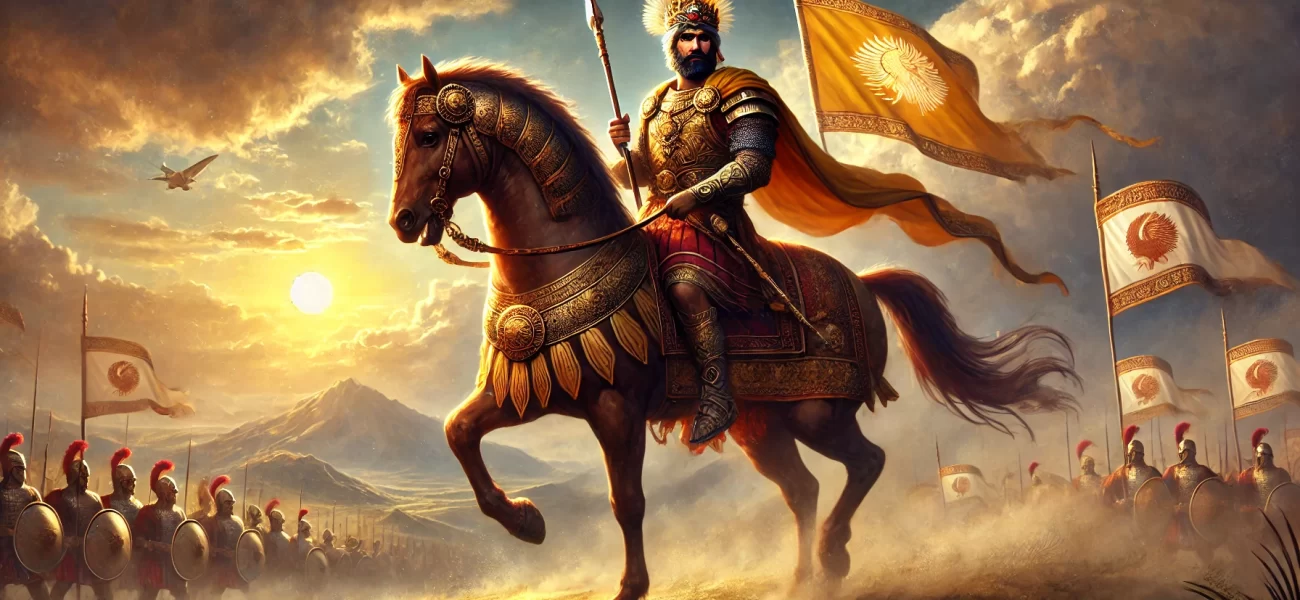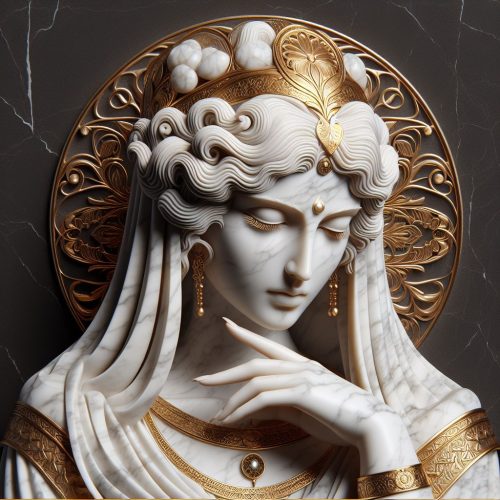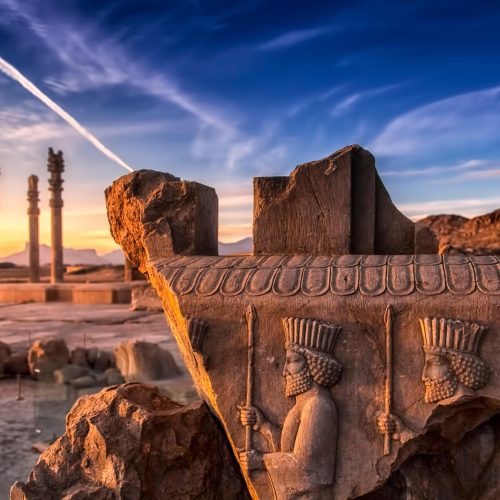In the annals of human history, there emerges, from time to time, a figure so grand and so resolute that his very name resonates across the epochs. Darius the Great, the illustrious king of Persia, stands among such towering figures. His reign, marked by monumental achievements, vast conquests, and profound governance, laid the bedrock upon which the Achaemenid Empire reached its zenith. To truly fathom the magnitude of Darius’s influence, one must delve deep into the rich tapestry of his life, exploring the origins, triumphs, and legacies that have immortalized him in the chronicles of time.
Early Life
Born in 550 BCE, Darius, son of Hystaspes, descended from the prestigious Achaemenid dynasty, a lineage whose roots reached deep into the history of the Persian people. His early life, though not as well-documented as his later achievements, was profoundly shaped by the traditions and expectations of Persian royalty. Darius’s birthplace is believed to be in the region of Persis (modern-day Fars province in Iran), a land characterized by rugged mountains and fertile plains—a fitting backdrop for a future king destined to leave an indelible mark on history.
The Achaemenid family, to which Darius belonged, was steeped in the ideals of leadership and governance. His father, Hystaspes, was a satrap (governor) of the Persian province of Parthia under the reign of Cyrus the Great, the founder of the Persian Empire. From Hystaspes, Darius inherited not just a noble title but a deep understanding of the responsibilities that came with governance. The young prince was groomed for leadership from an early age, receiving an education befitting his station. This education was comprehensive, encompassing not only military training and physical endurance but also the study of governance, law, and the religious tenets of Zoroastrianism, which would later play a significant role in his reign.
In the austere courts of Persis, where the grandeur of the Achaemenid legacy loomed large, Darius was inculcated with the values that would define his future rule: justice, courage, and the sacred duty to protect and expand the empire. The Achaemenid princes were expected to be warriors first and foremost, but they were also taught to be wise rulers, capable of understanding the complex dynamics of an empire as vast and diverse as Persia.
Darius’s early life was likely filled with rigorous training in archery, horsemanship, and the art of war, preparing him for the military campaigns that would later define much of his reign. Yet, beyond the martial skills, Darius was also exposed to the intricate workings of Persian administration. He observed the governance of provinces, the collection of taxes, and the delicate balance required to maintain the loyalty of satraps and local rulers. This early exposure to the mechanisms of statecraft would serve him well in his later years when he would need to consolidate his power and manage the sprawling territories of the Persian Empire.
Moreover, Darius’s formative years were influenced by the Zoroastrian faith, which was deeply intertwined with the Achaemenid conception of kingship. Zoroastrianism, with its emphasis on the duality of good and evil, truth and falsehood, would have instilled in young Darius a strong sense of moral duty. Ahura Mazda, the supreme god of Zoroastrianism, was seen as the protector of truth (Asha) and the enemy of chaos (Druj). As a future king, Darius would have been taught that his role was to uphold Asha in all his actions, to be a ruler who embodied truth and justice, and to wage a perpetual struggle against the forces of chaos and falsehood. This religious foundation would later be evident in Darius’s proclamations and inscriptions, where he often invoked the favor of Ahura Mazda as the source of his legitimacy and power.
In addition to his formal education, Darius would have been influenced by the oral traditions and stories passed down through generations. Tales of his ancestors, particularly Cyrus the Great, who had forged the Persian Empire, and Cambyses II, who had expanded it, would have served as both inspiration and a daunting benchmark for the young prince. These stories were not merely historical accounts; they were lessons in leadership, valor, and the responsibilities of kingship. Darius would have learned from these narratives the importance of wisdom in decision-making, the need for courage in battle, and the value of clemency and justice in governance.
However, the world into which Darius was born was not one of unchallenged power and security. The Persian Empire, though vast and formidable, was a patchwork of diverse cultures, languages, and religions. The young Darius would have been acutely aware of the empire’s vulnerabilities, the constant threat of rebellion, and the challenges of ruling over such a diverse populace. These early realizations likely fostered in him a cautious and strategic mindset, one that would later define his approach to both governance and warfare.
Darius’s early life, therefore, was one of preparation—preparation for a role that he may not have been destined to inherit directly, but one for which he was undoubtedly groomed. Though he was not the immediate heir to the throne, the skills, knowledge, and values instilled in him during his formative years laid the foundation for his future as one of Persia’s greatest rulers. When the time came, Darius would draw upon this reservoir of experience, education, and faith to navigate the tumultuous path to power and to lead the Persian Empire into a golden age of prosperity and expansion.
Accession
The accession of Darius to the throne of Persia is a tale steeped in intrigue, treachery, and the divine will that was believed to guide the fate of kings. Upon the death of Cambyses II, the son of Cyrus the Great, the Persian Empire was thrust into a maelstrom of chaos and uncertainty. The throne was usurped by a man, purportedly an imposter, who claimed to be Bardiya, the brother of Cambyses II. This “false Bardiya,” as he was later known, held the reins of power through deceit, igniting fears and unrest throughout the empire.
It was in this turbulent milieu that Darius, then a young satrap and a member of the royal guard, rose to prominence. Supported by six other noble Persian families, Darius led a successful coup against the false Bardiya, thus restoring the legitimate line of Achaemenid kingship. The accounts of Darius’s accession, immortalized in the Behistun Inscription, reveal a ruler ordained by Ahura Mazda, the supreme deity of Zoroastrianism, to restore order and justice to the realm.
Early Reign
With the usurpation quelled and the throne secured, Darius’s early reign was characterized by a series of consolidations and reforms designed to stabilize and strengthen the vast empire he had inherited. A keen observer of the diverse cultures and peoples under his dominion, Darius understood that his rule would be fortified not by mere force, but through efficient governance and respect for the empire’s multifaceted populace.
One of Darius’s first acts as king was the establishment of a new administrative structure, which would become a hallmark of Achaemenid governance. The empire was divided into provinces, or satrapies, each governed by a satrap appointed by the king. These satraps were charged with maintaining order, collecting taxes, and overseeing the local administration, all under the watchful eye of royal inspectors, the “King’s Eyes.” This system allowed Darius to exercise control over the far-flung territories of his empire, ensuring that the will of the king was executed from the shores of the Aegean to the borders of India.
Early Revolts
Despite these reforms, Darius’s early reign was far from peaceful. The consolidation of power and the legitimacy of his rule were challenged by several revolts that erupted across the empire. These revolts, which broke out in places as far-flung as Elam, Babylon, and Media, were incited by local leaders who sought to exploit the perceived weakness of a newly enthroned monarch.
Darius, however, was not a ruler to be trifled with. With the same decisiveness that had brought him to power, he moved swiftly to quash these insurrections. The Behistun Inscription, a monumental relief carved into a cliff face in western Iran, provides a detailed account of these early struggles, depicting Darius triumphantly standing over his vanquished foes. Through these victories, Darius not only reaffirmed his authority but also established a reputation as a formidable and just ruler, whose right to rule was divinely sanctioned and unassailable.
Elimination of Intaphernes
Among the early challenges faced by Darius was the conspiracy led by Intaphernes, one of the noblemen who had initially supported Darius’s ascent to the throne. Intaphernes, perhaps emboldened by his role in the overthrow of the false Bardiya, sought to assert his own power and challenge Darius’s authority. The precise details of this conspiracy remain shrouded in the mists of antiquity, yet the outcome is well-documented: Darius, in an act of both justice and political necessity, ordered the execution of Intaphernes and his family.
This event, while brutal, served as a stern warning to other nobles who might harbor similar ambitions. It underscored the absolute power of the king and the perils that awaited those who dared to defy the authority of the Achaemenid throne. The elimination of Intaphernes was a crucial moment in Darius’s reign, reinforcing the principle that loyalty to the king was paramount, and treachery would be met with swift and merciless retribution.
Military Campaigns
Darius’s reign is perhaps most celebrated for the extensive military campaigns that expanded the Persian Empire to its greatest territorial extent. A warrior king, Darius understood that the strength and security of his empire lay not only in its internal stability but also in the projection of power beyond its borders.
Egyptian Campaign
Among the first of these military undertakings was the Egyptian campaign. Egypt, a land of ancient civilization and immense wealth, had fallen under Persian control during the reign of Cambyses II. However, the death of Cambyses and the subsequent turmoil of the false Bardiya’s rule had emboldened the Egyptians to rebel against Persian domination.
In 518 BCE, Darius personally led a campaign to reassert Persian authority over Egypt. This campaign, meticulously planned and executed, resulted in the swift subjugation of the rebellious province. Darius, ever the pragmatist, sought not only to conquer but to win the hearts of the Egyptian people. He portrayed himself as the legitimate successor to the Pharaohs, adopting Egyptian titles and participating in traditional religious rituals. This policy of cultural assimilation ensured the long-term stability of Persian rule in Egypt, a province that would remain under Achaemenid control for nearly two centuries.
Invasion of the Indus Valley
Having secured the western and central regions of his empire, Darius turned his gaze eastward towards the rich and fertile lands of the Indus Valley. The invasion of the Indus Valley, undertaken around 515 BCE, was a monumental campaign that extended the boundaries of the Persian Empire into the Indian subcontinent.
The Indus Valley, with its thriving cities and prosperous trade routes, was a prize that Darius could not ignore. The Persian forces, led by Darius’s trusted generals, encountered fierce resistance from the local rulers, yet the superior organization and military prowess of the Persians ultimately prevailed. The conquest of the Indus Valley brought vast wealth into the empire and established Persian dominance over one of the most vibrant regions of the ancient world. Furthermore, it opened up new avenues for trade and cultural exchange between Persia and the distant lands of India, enriching the empire both materially and intellectually.
Babylonian Revolt
Not all of Darius’s campaigns were expansionist in nature; some were aimed at maintaining control over the empire’s existing territories. The Babylonian revolt of 522-521 BCE is a prime example of such efforts. Babylon, a city of immense historical and cultural significance, had been under Persian rule since the time of Cyrus the Great. However, the instability following Cambyses’s death led to a resurgence of Babylonian nationalism and a revolt against Persian authority.
Darius, recognizing the strategic importance of Babylon, acted swiftly to suppress the rebellion. The campaign against Babylon was conducted with both military force and psychological warfare. Darius’s armies besieged the city, and after a protracted struggle, they succeeded in breaching its formidable defenses. The fall of Babylon was a critical victory for Darius, as it not only restored Persian control over a vital region but also demonstrated the futility of resistance against the might of the Achaemenid Empire.
European Scythian Campaign
One of the most ambitious and daring of Darius’s military campaigns was the European Scythian campaign, undertaken around 513 BCE. The Scythians, a nomadic people inhabiting the vast steppes north of the Black Sea, posed a persistent threat to the northern borders of the Persian Empire. Darius, ever the strategist, sought to neutralize this threat by launching a preemptive invasion of Scythian territory.
The campaign, which saw Persian forces crossing the Bosporus into Europe, was fraught with challenges. The Scythians, adept in the art of guerilla warfare, avoided direct confrontation with the Persian army, instead employing hit-and-run tactics that frustrated Darius’s attempts to bring them to battle. Despite the difficulties, Darius managed to establish Persian control over Thrace and other territories in the region, extending the influence of the empire into Europe. Although the campaign did not result in the outright conquest of the Scythians, it achieved its primary objective of securing the empire’s northern frontier and deterring future incursions by the nomadic tribes.
Persian Invasion of Greece
The Persian invasion of Greece, often regarded as the most famous of Darius’s military campaigns, was a defining moment in the history of both Persia and the ancient world. This campaign, which began in 492 BCE, was motivated by a combination of strategic interests and a desire to punish the Greek city-states that had supported the Ionian Revolt against Persian rule.
Darius’s forces, under the command of his generals, initially met with success, subjugating Thrace and the islands of the Aegean Sea. However, the campaign culminated in the famous Battle of Marathon in 490 BCE, where the Persian army was decisively defeated by the Athenians. This defeat, though a setback for Darius, did not diminish the grandeur of his reign. It is important to note that while the invasion of Greece is often highlighted in Western historiography as a moment of Persian failure, within the broader context of Darius’s reign, it was but one episode in a long and illustrious career of military and administrative achievements.
Family
Darius’s personal life, particularly his family, played a significant role in the governance and stability of the Persian Empire. As was customary for Persian kings, Darius had several wives, most notably Atossa, the daughter of Cyrus the Great. Atossa, a woman of great influence and intelligence, bore Darius several sons, including his successor, Xerxes I. Through his marriage to Atossa, Darius not only solidified his claim to the throne but also ensured the continuity of the Achaemenid dynasty.
Darius’s family was intricately involved in the administration of the empire. His sons were appointed to key positions, governing various provinces and leading military campaigns. This delegation of power to trusted family members helped maintain the cohesion of the empire and ensured that the Achaemenid line remained unbroken.
Death and Succession
Darius’s reign, which spanned thirty-six years, came to an end in 486 BCE. The circumstances of his death, though not extensively documented, suggest that he died of natural causes, likely due to old age. His passing marked the end of an era, yet the legacy of his rule was carried forward by his son, Xerxes I.
The succession of Xerxes was smooth, largely due to the careful planning and grooming by Darius. Unlike the chaotic transitions that had plagued previous successions, the handover of power to Xerxes was orderly and uncontested. This stability can be attributed to Darius’s foresight and the strong foundations of governance he had laid during his reign.
Government
Darius’s contributions to the governance of the Persian Empire cannot be overstated. He was a ruler who understood that the success of his empire depended not only on military might but also on the efficient and just administration of its vast territories.
One of Darius’s most significant reforms was the codification of laws. Recognizing the diversity of his empire, which encompassed a myriad of cultures, languages, and traditions, Darius sought to create a system of laws that would be universally applicable, yet flexible enough to respect local customs. This legal code, often referred to as the “Darius Code,” provided a framework for justice that was both equitable and consistent, ensuring that all subjects of the empire were governed by the same principles of fairness.
Organization
The administrative organization of the Persian Empire under Darius was a marvel of efficiency and sophistication. The empire was divided into twenty satrapies, each governed by a satrap who acted as the king’s representative. These satraps were responsible for the collection of taxes, the administration of justice, and the maintenance of order within their respective provinces.
To ensure that the satraps remained loyal and effective, Darius instituted a system of checks and balances. Royal inspectors, known as the “King’s Eyes,” were dispatched to the provinces to monitor the satraps’ activities and report directly to the king. This system not only prevented corruption and abuse of power but also reinforced the central authority of the king.
Darius also established a standardized system of taxation, which was based on the wealth and productivity of each province. This system provided a steady stream of revenue for the empire, enabling Darius to fund his military campaigns, building projects, and other state expenditures.
Economy
The economy of the Persian Empire flourished under Darius’s rule. His administration implemented policies that promoted trade, agriculture, and industry, resulting in a period of unprecedented economic prosperity.
One of Darius’s most notable economic achievements was the introduction of a standardized coinage system. The Daric, a gold coin named after the king, became the standard currency throughout the empire. This standardization facilitated trade and commerce, both within the empire and with neighboring regions, by eliminating the complexities and inefficiencies of barter and varied local currencies.
In addition to coinage, Darius invested heavily in infrastructure, particularly in the construction of roads and canals. The Royal Road, which stretched from Susa in Persia to Sardis in Asia Minor, was a testament to Darius’s vision of a connected and prosperous empire. This road, along with others like it, facilitated the movement of goods, people, and information across vast distances, fostering economic integration and cultural exchange.
Agriculture, the backbone of the empire’s economy, also thrived under Darius’s reign. The king implemented policies that supported farmers, encouraged the cultivation of new lands, and improved irrigation systems. These efforts resulted in increased agricultural productivity, which in turn supported the empire’s growing population and urban centers.
Religion
Religion played a central role in Darius’s life and reign. As a devout follower of Zoroastrianism, the ancient monotheistic religion of Persia, Darius saw his kingship as a divine mandate from Ahura Mazda, the supreme god of the Zoroastrian faith.
Darius’s religious beliefs were deeply intertwined with his governance. He viewed himself as the protector of truth and justice, core tenets of Zoroastrianism, and sought to govern in a manner that reflected these principles. The Behistun Inscription, one of the most important sources of information about Darius’s reign, is not only a historical record but also a religious testament. In it, Darius declares his devotion to Ahura Mazda and credits the god with granting him the strength and wisdom to rule.
While Zoroastrianism was the dominant religion of the Persian Empire, Darius was known for his tolerance of other faiths. The empire was home to a diverse array of religions, including those of the Babylonians, Egyptians, and Greeks. Darius’s policy of religious tolerance allowed these faiths to coexist within the empire, fostering a sense of unity and stability among his subjects.
Building Projects
Darius’s reign was marked by an ambitious program of building projects, which reflected both his desire to glorify the Persian Empire and his practical need to improve its infrastructure. These projects, which ranged from monumental palaces to utilitarian roads, left an indelible mark on the landscape of the empire.
One of Darius’s most famous building projects was the construction of Persepolis, a grand ceremonial capital located in the heart of Persia. Persepolis, with its magnificent palaces, grand halls, and intricate reliefs, was a testament to the power and grandeur of the Achaemenid Empire. The city served as a center of administration and a stage for the king’s most important ceremonies, including the annual tribute-giving by the empire’s subject peoples.
In addition to Persepolis, Darius also oversaw the construction of Susa, another important capital, and the refurbishment of Babylon, which had been damaged during the earlier revolt. These cities were not only centers of political power but also hubs of culture and learning, attracting scholars, artists, and merchants from across the empire.
Darius’s building projects extended beyond palaces and cities. He also commissioned the construction of canals, such as the one that connected the Nile River to the Red Sea, facilitating trade between Egypt and the Persian Gulf. This canal, known as the “Canal of the Pharaohs,” was a remarkable feat of engineering that exemplified Darius’s vision of a connected and prosperous empire.
Conclusion
Darius the Great, in his wisdom and might, forged an empire that stood as a beacon of civilization in the ancient world. His reign was marked by a relentless pursuit of justice, an unwavering commitment to governance, and a vision of empire that extended far beyond the borders of Persia. Through his military campaigns, administrative reforms, and monumental building projects, Darius not only secured the legacy of the Achaemenid dynasty but also laid the foundations for a world order that would endure for centuries. As we reflect upon the life and achievements of Darius the Great, we are reminded of the timeless virtues of leadership, wisdom, and justice that he embodied. His legacy, etched in the stone of the Behistun Inscription and the hearts of his people, continues to inspire and instruct us, offering lessons that are as relevant today as they were in the ancient world.




